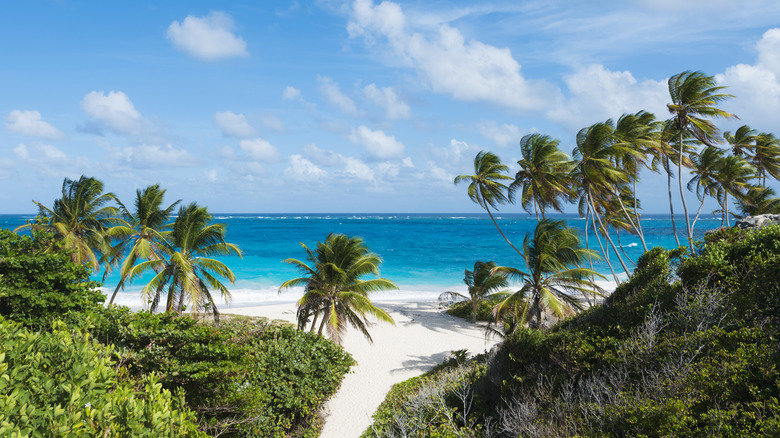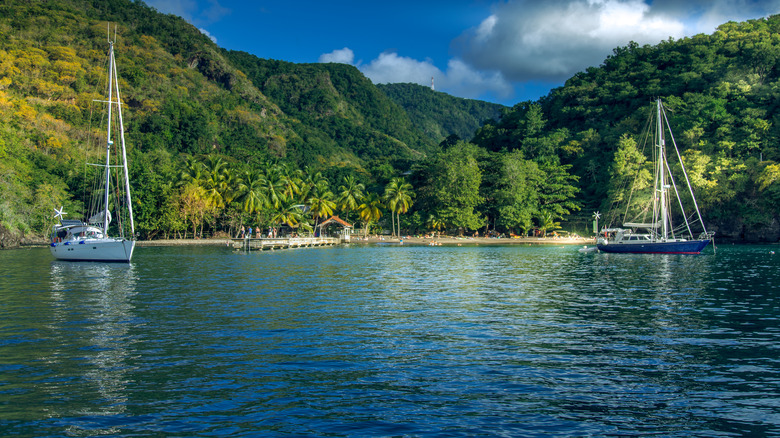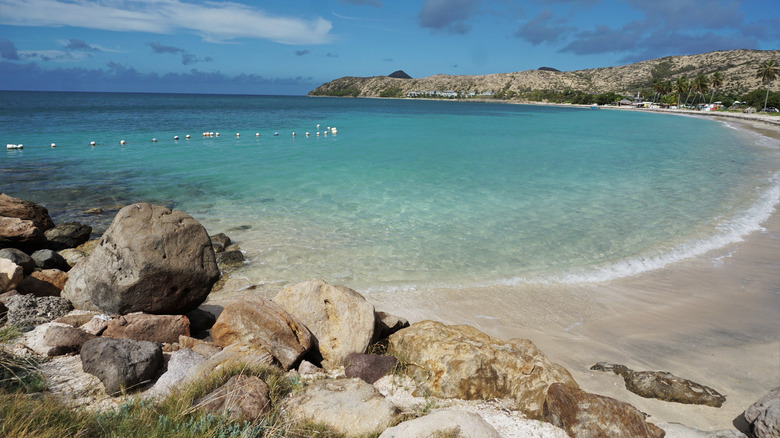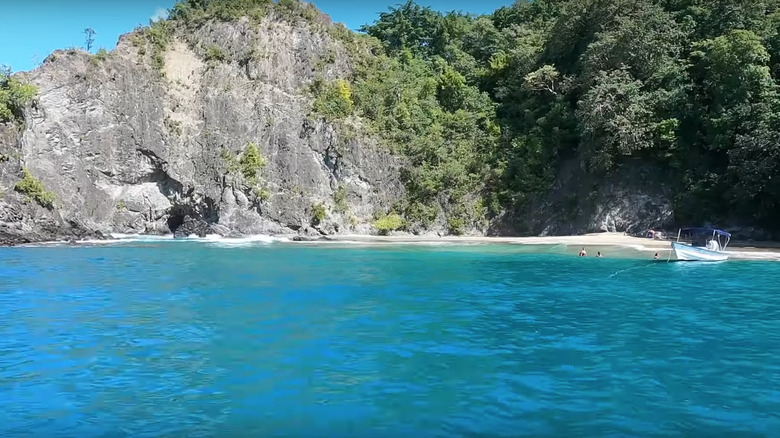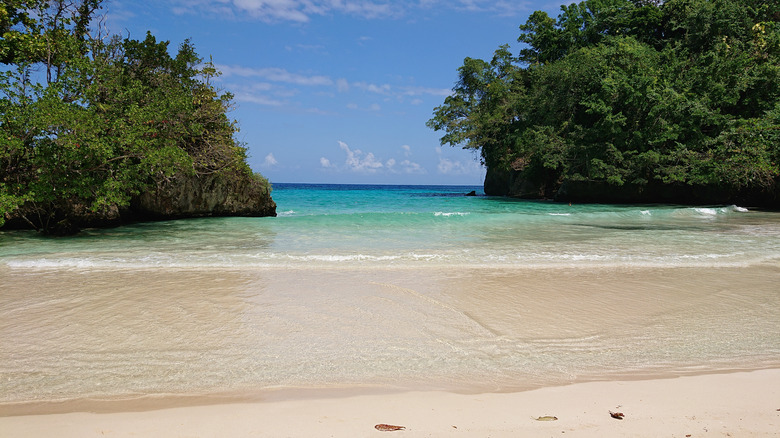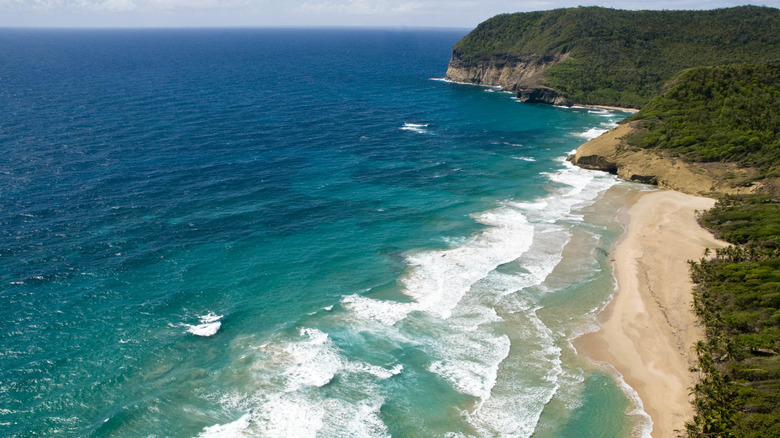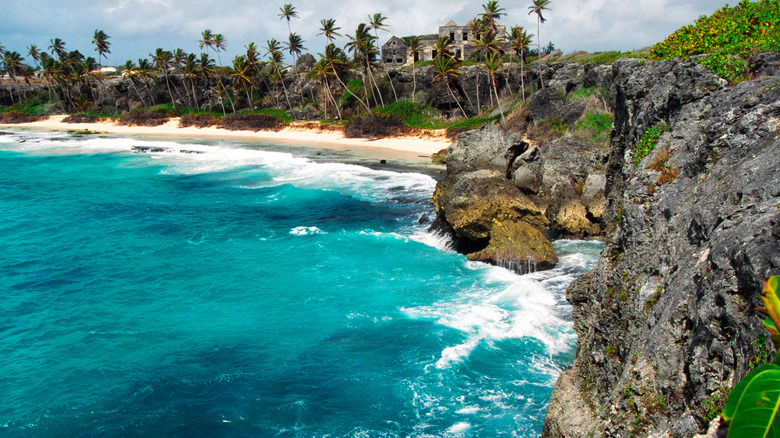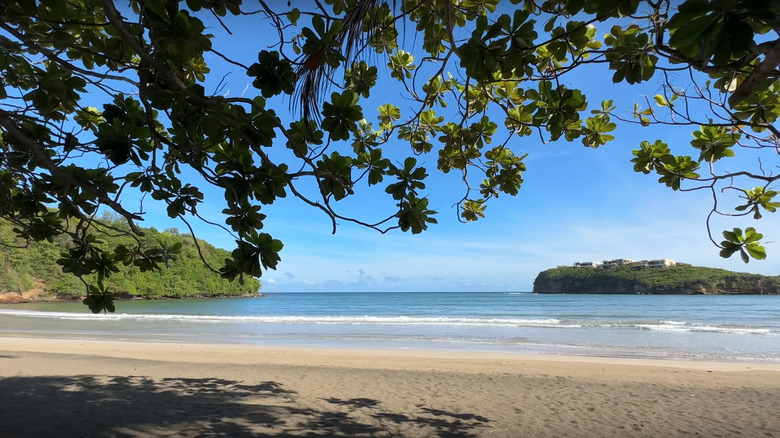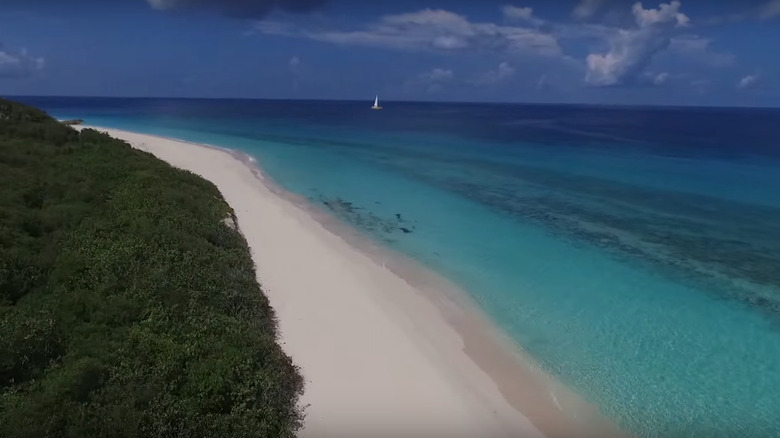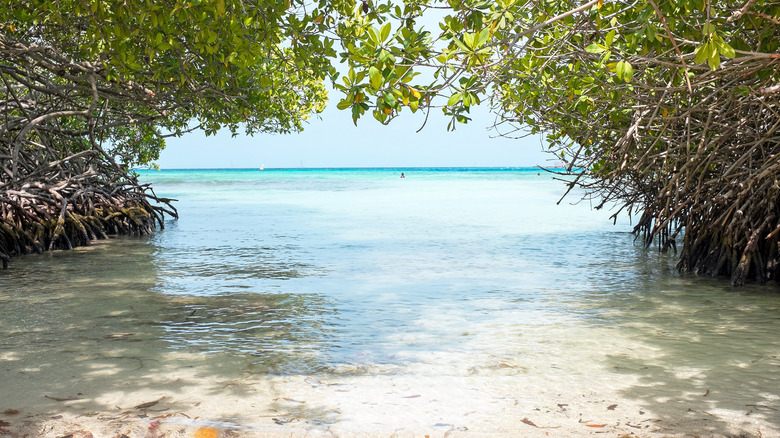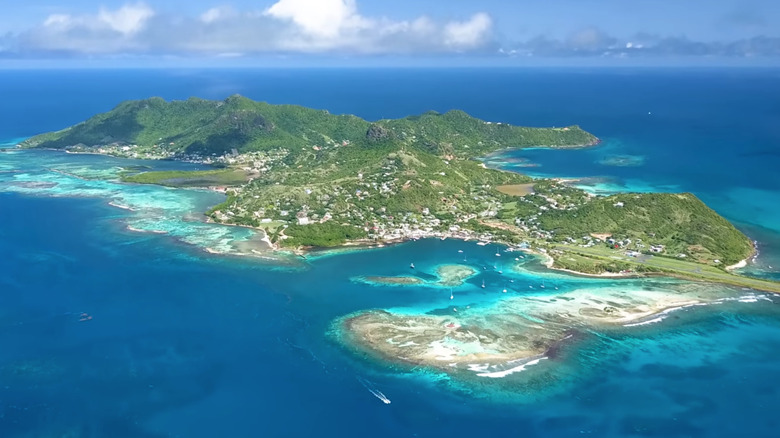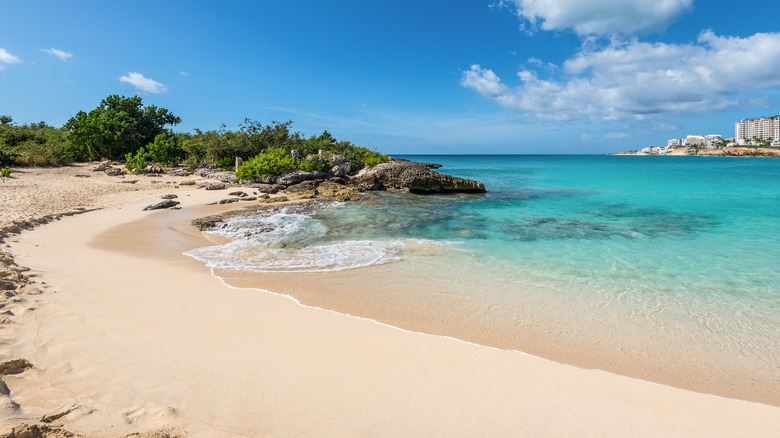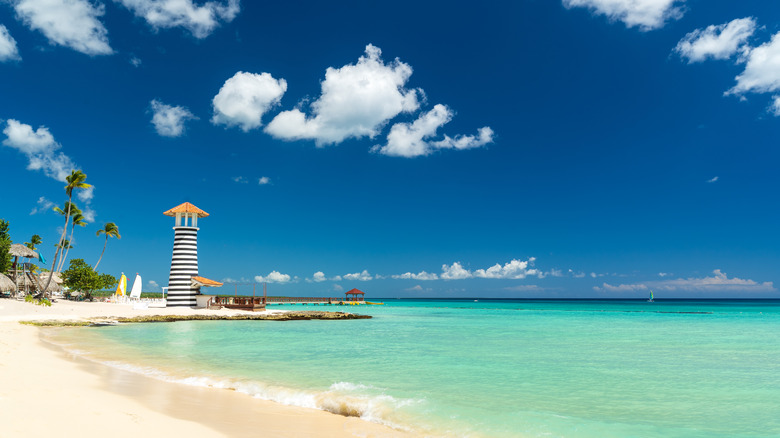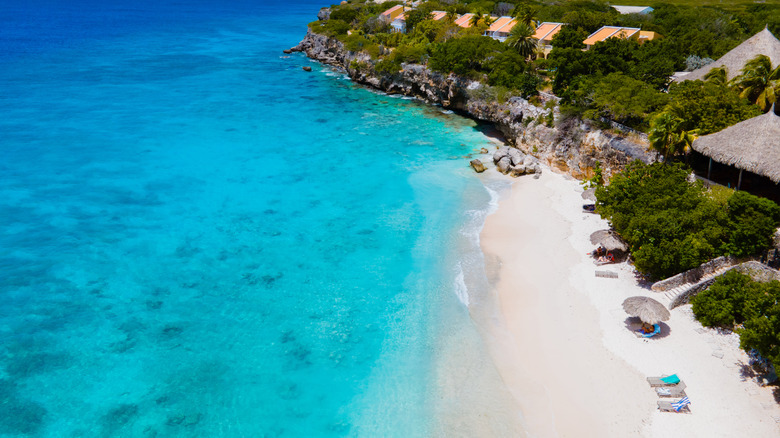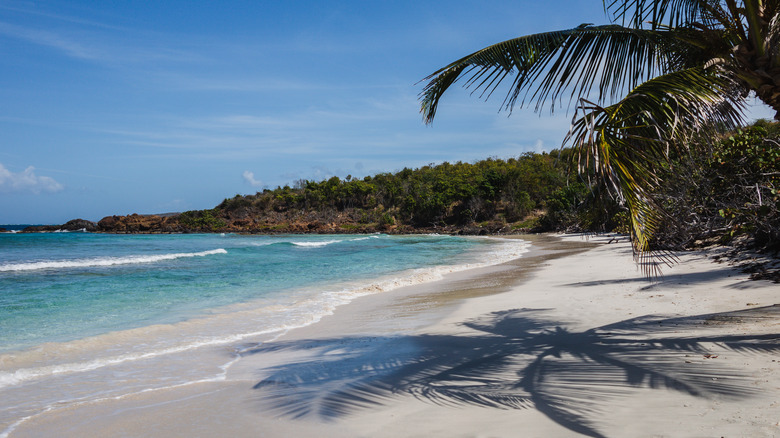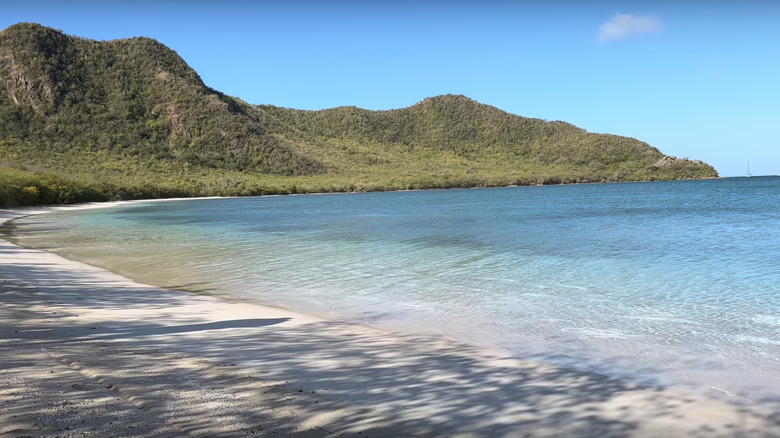Under-The-Radar Beaches You Need To Visit In The Caribbean
Can anything be more alluring in the Caribbean than its dizzyingly gorgeous beaches? From north to south, a scattering of islands that stretch from near Florida all the way down to the edges of South America, these jewels are blessed by some of the finest seas on the planet. And welcoming those waters onto the shore are the beaches that attract travelers every day, all year round. Every tourist will have their favorite beach in the Caribbean — some beloved because of its facilities, a handful for the atmosphere, and others for its simplicity.
There are beaches on each island that clearly win the popular vote and are rarely empty; this usually happens for a good reason. But this doesn't mean that travelers have to spend their time on these slips of sand; for every beach blanketed with sun worshippers, there are many more out there that promise fabulous swimming without the crowds. And while Mexico and some Central and South American countries have shorelines that hug the Caribbean Sea, a good place to start when discovering hidden gems, like our list below, focuses on the islands.
Anse Noire, Martinique
Located in the southwest of the French island of Martinique, this small beach doesn't have sweeping stretches of golden or white sand; instead, the powder is black, showing evidence of volcanic activity. Behind the beachfront, the dense, verdant landscape adds a pretty contrast to the seascape, while the water in front is calm and incredibly clear. The color of the sand makes Anse Noire stand out on this island, the only beach on Martinique with sand shaded in this hue.
Access to the shore entails parking on higher ground before descending a long staircase to a compact cove with a skinny concrete pier and forested headlands reaching out at both ends. The water is warm and tranquil, thanks in part to those headlands and also because the beach faces toward the Caribbean Sea (unlike the east coast beaches that look onto the Atlantic). For fans of marine life, there are many sponges, turtles, and fish in the shallows and depths offshore.
Banana Bay, St. Kitts
Located on the south end of St. Kitts, at the end of the tail that protrudes down from the main bulk of the island, this beach looks across The Narrows to sister island Nevis, with its towering central peak. Banana Bay is beautifully low-key with tall, skinny palms, slender strips of light golden sand, and glorious turquoise water. But its beauty — and Cockleshell Beach right next door — is that it isn't super developed. Park Hyatt opened there a few years ago, but its buildings are low-rise, so its presence isn't overpowering.
Sure, there are food vendors along Cockleshell Beach, and the sands fill up on weekends with beachgoers. Still, the place has a thrown-together feel, a sense of untapped tropical splendor that waterfront high-rises and international chain restaurants could have easily ruined. Visit during the week to enjoy the beach and water as nature intended it.
Cotton Bay, Tobago
Finding a beach without anyone else on it is a treat, like stumbling on a nugget of treasure at the edge of open water. This bay on the north coast of the island of Tobago is likely to be pretty empty most of the time because getting here requires hiring a boat — there are no roads close to the beach, ensuring that the usual drive-park-shuffle-to-the-beach traffic is nowhere to be seen.
The waters here are a gorgeous shade of blue-green, gently lilting between the tree-blanketed headlands that bookend the beach, and they are great for snorkeling, with plenty of fish and squid wandering the shallows. At one end of the beach, a large rock seems to sprout from the water, separated from the mainland, creating a small channel between the two that is fun to explore with a snorkel or by foot if the tide is low.
Frenchman's Cove, Jamaica
A little east of Port Antonio on Jamaica's north coast, this small cove tightly hemmed between forested headlands is pure bliss. The beach is part of the resort, and its name, according to the grapevine, refers to an intense battle on the grounds between the British and the French, with the latter prevailing. The resort opened in the 1960s, a ritzy retreat comprising individual villas and a main house that has welcomed the upper echelons of aristocracy and entertainment from around the world, including the late Queen Elizabeth II, The Beatles, and Marlon Brando.
The property has faded a little since its heyday and is no longer the domain of the rich and famous, and these days travelers don't need to stay here to visit the sumptuous beach; a day pass for a non-guest aged 12 costs J$1,800 (about US$12). The conditions here are dreamy — the turquoise water gently lapping at the shore, the tall and densely green headlands, and the soft and clean sand. Adding to the allure is a small stream nearby that flows into the sea all the way from the Blue Mountains.
Grand Anse, St. Lucia
Set on the northeast coast of St. Lucia, the beach doesn't get the crowds to which other Caribbean islands are accustomed due to challenging topography and the lack of easy access. The nearest settlement is Des Barras; as a result, Grande Anse is sometimes known as Des Barras Beach. Getting to the waterfront from the local community requires traversing unpaved routes and navigating terrain not designed for mass tourism.
The water of Grande Anse also tends to be quite unruly since the eastern beaches cede to the open Atlantic, so this isn't a typical, tranquil, float-in-the-water Caribbean beach. But what makes it special is the rugged nature and rocky landscape, a welcome contrast to the beaches west of St. Lucia. There is also a chance to see rich birdlife and a number of turtle species, including Hawksbill and leatherback, that nest here between February and October.
Harrismith Beach, Barbados
The easternmost island in the Caribbean, Barbados, sometimes feels like a space all its own, set a little beyond the loose arc that runs through the islands connecting Jamaica to Trinidad and Tobago on a map. In the south of Barbados, set below cliffs and beautified by lovely palm trees, this beach is often overlooked in favor of its more popular neighbor a few minutes walk to the north. Bottom Bay is an archetypal Caribbean beach, a vast stretch with brilliant white sand, baby blue swells rolling to the shore, and plenty of visitors sunning themselves at this slice of paradise.
Yet Harrismith Beach, which is much smaller and just a short walk away, feels all but forgotten, which is a plus for anyone who comes here. With a small lagoon and a reef that ensures the waves are never big, it's a great and safe place to swim. On the cliff above it, a former plantation house that has fallen into disrepair stands sentry, an interesting place to wander when you need a break from the aquatic ecstasy.
La Sagesse, Grenada
The southern coast of the island of Grenada is heavily indented, with little coves and bays tucked in between outcroppings and peninsulas that make up the undulating shore. This beach, which shares its name with the hotel it fronts, sits in one of those coves, a grand sweep with a curling sandy shore, leaning palm trees, and forested hills along the sides.
The beach is easy to reach by foot, a short walk from the road nearby, and is large enough that it never feels too busy. Visitors don't have to be a guest of the hotel to spend time on the beach, though taking a meal at the resort's beachside restaurant is a smart way to break up the day. Rooms here are simple, with vibrant Caribbean colors, artwork, and plenty of fresh flowers, making it a spot for honeymooners and couples who want to get away from it all.
Long Bay Beach, Anguilla
Any visitor to Anguilla, or fan of Caribbean beaches, will know about Meads Bay, a fabulous ribbon of sand that's home to one of the plushest resorts in the Caribbean — Malliouhana — and that has calm, clear, achingly beautiful turquoise water in front. And yet, Long Bay Beach, a short distance to the northeast of Meads Bay, somehow manages to escape the plaudits and the crowds.
It's certainly much quieter than its southwestern neighbor, and large sections remain undeveloped, with just a few private homes and villas on other parts. The water is as stunning as at Meads Bay, but without the visitors, and parts of the beach are home to rows of rock formations, which create small tide pools and add a little visual variety to the beachscape. This does feel a million miles away from the far more popular destination that sits just down the coast.
Mangel Halto, Aruba
Aruba sits outside the hurricane belt and stays warm all year round, making it a good destination in any season. It is also blessed with plenty of stunning stretches of sand, from the super tranquil Baby Beach in the south (named, possibly, for its calm conditions that even a baby would enjoy), to the more lively Arashi Beach in the north, where pelicans frequently dive into the waters in search of some daily sustenance.
A quiet beach among the mangroves that is great for snorkeling is Mangel Halto, a short distance southeast of the international airport. There are a number of different entry points into the water, down some steps directly from the road, from a small floating dock by the shore, or through small gaps among the mangroves. The water is shallow, quite a way out, and if you don a mask and snorkel, you might see parrot fish, tangs, and striped sergeant majors.
Miss Irene Beach, Saint Vincent and the Grenadines
The islands of St. Vincent and the Grenadines are where to find some of the most striking seascapes anywhere on the planet, with clear, electric blue seas filling the spaces between the nation's various islands. Some of that water is on display at this unheralded, small beach near the southern tip of Union Island, which has heart-melting views of the gorgeous seas and nearby Frigate Island, a spot popular with kite surfers. Miss Irene Beach won't wow visitors with a heavy roster of offerings or facilities but will charm with its implicit simplicity, a sober section of sand with no concessions or stalls and little shade, but with super soft white sand and water that screams to be jumped into.
In a sense, this beach reflects the sensibilities of this island, wonderfully uncommercial and refreshingly easygoing. The main pleasures on Union Island, in general, are swimming in the warm water or hiking to the fort in the main village of Clifton, which offers great views of the island.
Mullet Bay, Sint Maarten
An island with a split personality — literally — Sint Maarten divides its land between French and Dutch halves. The latter half, which occupies the bottom part of the island, is where to find Mullet Bay, a long string of sand that is very popular with locals on the weekends, but during the week is relatively quiet, except on days when cruise ships dock, in which case expect some increased traffic. Whatever day you plan to visit, the water is gorgeously clear and can vary from calm to small rolls that entice surfers.
On Mullet Bay, adventure operators rent out Jet skis for thrill seekers who want to rip through the waters for high-octane excitement. Golfers might be interested to learn that the beach sits in close proximity to the island's sole 18-hole golf course, the Mullet Bay Golf Course, which winds its way around a gorgeous lagoon.
Playa Bayahibe, Dominican Republic
The words La Romana, a town in the Dominican Republic with its international airport, are synonymous with plush resorts. This, after all, is where to find the gated Casa de Campo Resort & Villas, whose golf course has won numerous accolades and has its marina. Down the coast, the Hilton La Romana all-inclusive, geared strictly toward adults, is an equally extravagant affair, sitting on the gorgeous beach of Bayahibe. This small waterfront on the island's southern coast is a quiet place, and despite the Hilton resort, it has managed to retain its easy-going charm.
Most visitors come here to dive in the waters nearby or take a day trip to the small islands of Catalina and Saona, with boats leaving from the port of the village, more than a mile away. That ensures that the beach, which is a classic tropical idyll — think turquoise waters, coconut palms strung along the shore, and sugary sand that just crumbles underfoot — remains blissfully serene.
Playa Kalki, Curaçao
Curaçao is another country within the greater realm of the Netherlands, with breathtaking beaches all over its coastlines. At this beach on the island's northwest, in part of Curaçao known as Sabana Westpunt, the sand is soft, but there are also rocks here that make pleasant crunching sounds when the incoming waves roll over them, but it can be a little painful to walk over barefoot. The contrast between the blue sea and the whiteness of the sand is quite spectacular and blinding, and a few thatched palapas offer decent shade when the sun overwhelms.
Of course, visitors can also plunge into the divine water, which also offers excellent snorkeling. Access to Playa Kalki is from the small parking area above, from which steps lead down to the water. At sea level, travelers will notice a long pier on the left of the beach where boats moor. The beach isn't huge, but spending time here will leave a lasting impression.
Playa Zoni, Culebra
Located east of the main island of Puerto Rico, Culebra is where visitors to this U.S. territory come to detach from daily life. It's an unplugged destination focusing firmly on nature, not on flashy bars and restaurants and high-rise hotels and resorts. Culebra has a huge number of fans that prize its untouched splendor, and part of the island falls under the remit of the U.S. Fish & Wildlife Service as the Culebra National Wildlife Refuge.
The island does, however, have gorgeous beaches that draw tourists from near and far, and perhaps the most renowned of these is Flamenco, with clear, calm seas and soft sands that young kids, and even adults, love. As alluring, though, but with few facilities, Playa Zoni is another fascinating piece of waterfront, with the same sugary sand and hypnotic blue water as Flamenco but lacking restrooms, stalls, and a liberated sense of commercialism.
Seaforth Beach, Antigua
Antigua likes to boast about its 365 beaches, one for every day of the year, yet ask any visitor which one is their favorite, and a few standards invariably recur — Dickenson Bay, Carlisle Bay, and Jolly Beach, to name a few. This beach on the west coast, a little north of the village of Jennings, is off the beaten track, a hidden gem with many of the desirable attributes of many others on the island. These include soft sands and calm water in shades of blue that will put any spectator under a spell but without the crowds.
Seaforth Beach takes some effort to reach, either by an ATV, four-wheel drive jeep, or by hiking inland over hills, and that need for planning and exertion has helped the beach stay somewhat off the radar. The beach is long, about a mile from one end to the other, and quiet, backed by deep greenery and thriving mangroves. Given its remoteness, there are no facilities here, so bring everything you need, and prepare to drink in a beach experience beyond compare.
